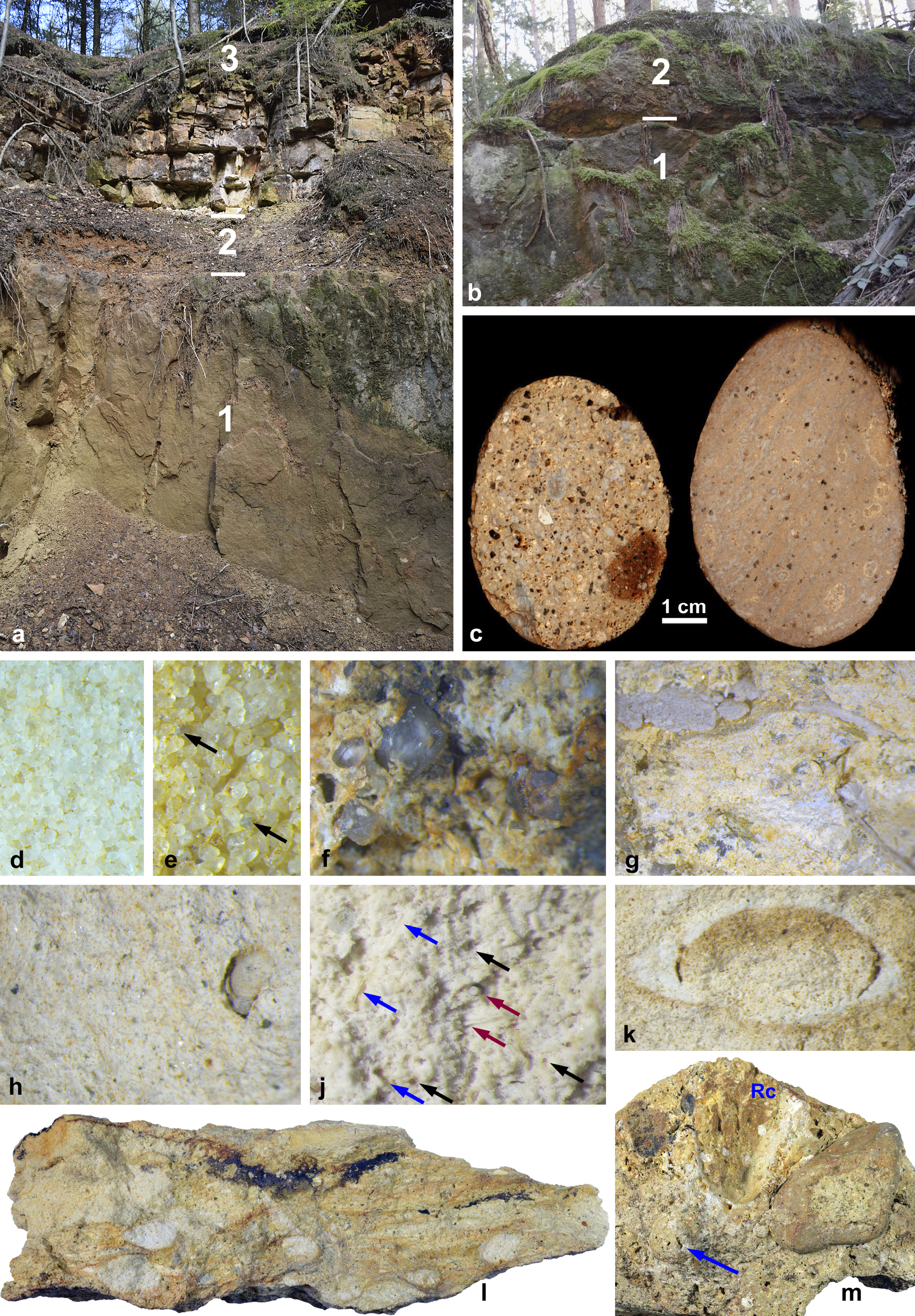
|
||
|
Gesteinsaufnahmen aus dem Sandsteinbruch am Flügel Jägerhorn. a, d, f–m heutiger Steinbruch Nr. 104; b, c, e alter Steinbruch Nr. 92; d–m Aufnahmen frisch gebrochener Gesteinsoberflächen (Fotos: B. Niebuhr 04/2021). a Gesamtansicht der Kreidesandsteine an der Westwand, Profilhöhe ca. 8 m; 1: Werksandstein der oberen Oberhäslich-Formation mit planarer Dachfläche; 2: tonige Mittel- bis Grobsandsteine mit dem Rhyolith-Konglomerat an der Basis, plenus-Horizont der unteren Pennrich-Formation; 3: gut gebankte, spiculitische Siltsteine (Plänersandsteine der mittleren Pennrich-Formation) (Foto: M. Wilmsen 2021). b Sequenzgrenze SB Ce 5, Bildbreite ca. 3 m; 1: Werksandstein der oberen Oberhäslich-Formation mit welliger Dachfläche; 2: grobes Rhyolith-Konglomerat als 80 cm mächtige, massive Bank (Foto: B. Niebuhr 04/2021). c polierte Oberfläche von wenig verwitterten Rhyolith-Geröllen aus dem Transgressionskonglomerat der Pennrich-Formation; links: phenokristallreicher Rhyolith („quarzreicher Porphyr“) und rechts: phenokristallarmer Rhyolith in Ignimbrit-artiger Entwicklung („quarzarmer Porphyr“) aus der Tharandter-Wald-Caldera (Fotos: F. Haubrich 2020). d FJ 1, sehr gut sortierter, mittelkörniger Quarzsandstein mit kieseligem Zement, Werksandstein der oberen Oberhäslich-Formation, Bildbreite 7,5 mm. e FJ 2, sehr gut sortierter, mittelkörniger Quarzsandstein mit wenig hell-gelblichgrünem Glaukonit (Pfeile) und kieselig-limonitischem Zement, Werksandstein der oberen Oberhäslich-Formation, Bildbreite 3,8 mm. f FJ 3, idiomorphe Quarzdihexaeder in einem glaukonitführenden, tonigen Grobsandstein, Rhyolith-Konglomerat der basalen Pennrich-Formation, Bildbreite 7,5 mm. g FJ 7, knollige, glaukonitische Feinsandsteine mit vielen verkieselten Bioklasten, untere Pennrich-Formation, Bildbreite 15 mm. h FJ 10, stark verkieselter, spiculitischer Siltstein mit Glaukonit und vielen, großen Hellglimmern sowie Lösungshohlräume kleiner Bioklasten (rechts), mittlere Pennrich-Formation, Bildbreite 7,5 mm. j FJ 13, monaxone Megaskleren als kreisrunde Löcher (schwarze Pfeile), teilweise mit sekundär verkieselter Füllung der Innenkanäle (rote Pfeile), oder in Längserstreckung (blaue Pfeile) im spiculitischen Siltstein, mittlere Pennrich-Formation, Bildbreite 5,8 mm. k FJ 10, augenförmige Verkieselung um einen kompaktierten Krebsgang herum (?Thalassinoides suevicus), mittlere Pennrich-Formation, Bildbreite 11 mm. l FJ 8, gelbfleckiger, inhomogener Fein- bis Mittelsandstein mit Glaukonit, großen isolierten Quarzkörnern, vielen Holzresten und weißen, feinsandig gefüllten Krebsgängen, untere Pennrich-Formation, Bildbreite 17 cm. m FJ 4, Transgressionskonglomerat der basalen Pennrich-Formation mit kaum verwittertem Rhyolith-Geröll (rechts) und vollständig kaolinisiertem Geröll (links, Pfeil), zwischen beidem eine verkieselte Schale von Rastellum carinatum (Rc), Bildbreite 8 cm. Figure 12. Rock photographs from the sandstone quarry at the Flügel Jägerhorn. a, d, f–m, recent quarry no. 104; b, c, e old quarry no. 92; d–m images of fresh-brocken rock surfaces (photos: B. Niebuhr 04/2021). a General view of the Cretaceous sandstones at the western wall, section height ca. 8 m; 1: sandy freestone of the upper Oberhäslich Formation with planar top surface; 2: clayey, medium- to coarse-grained sandstones with the rhyolite conglomerate at the base, plenus horizon of the lower Pennrich Formation; 3, well bedded, spiculitic-glauconitic siltstones (Pläner Sandstones of the middle Pennrich Formation) (photo: M. Wilmsen 2021). b Sequence boundary SB Ce 5, width of photo ca. 3 m; 1: sandy freestone of the upper Oberhäslich Formation with wavy top surface; 2: coarse rhyolite conglomerate as 80 cm thick, massive bed (photo: B. Niebuhr 04/2021). c polished surface of rhyolite cobbles from the transgression conglomerate of the Pennrich Formation; left: phenocrystalline rhyolite (“quartz-rich porphyry”) and right: phenocrystalline rhyolite in ignimbrite-like development (“quartz-poor porphyry”) from the Tharandter Wald Caldera (photo: F. Haubrich 2020). d FJ 1, very well sorted, medium-grained quartz-sandstone with siliceous cement, sandy freestone of the upper Oberhäslich Formation, width of photo 7.5 mm. e FJ 2, very well sorted, medium-grained quartz-sandstone with a few light yellow-greenish glauconite (arrows) and siliceous-limonitic cement, sandy freestone of the upper Oberhäslich Formation, width of photo 3,8 mm. f FJ 3, idiomorphic quartz-dihexaeder in a glauconite-bearing, clayey coarse-grained sandstone, rhyolite conglomerate of the basal Pennrich Formation, width of photo 7.5 mm. g FJ 7, nodular, glauconitic fine-grained sandstone with several silicified bioclasts, lower Pennrich Formation, width of photo 15 mm. h FJ 10, strongly silicified, spiculitic siltstone with glauconite and several, large white mica flakes as well as dissolved cavities of small bioclasts (right), middle Pennrich Formation, width of photo 7.5 mm. j FJ 13, monaxone megascleres of siliceous sponges visible as circular holes (black arrows), partly with secondary silicified filling of their internal cavities (red arrows), or in longitudinal extension (blue arrows) in a spiculitic siltstone, middle Pennrich Formation, width of photo 5.8 mm. k FJ 10, eye-shaped silicification around a compacted crustacean burrow (?Thalassinoides suevicus), middle Pennrich Formation, width of photo 11 mm. l FJ 8, yellow-stained, inhomogeneous fine- to medium-grained sandstone with glauconite, large isolated quartz grains, several wood remains and white crustacean burrows filled with fine-grained sand, lower Pennrich Formation, width of photo 17 cm. m FJ 4, transgression conglomerate of the basal Pennrich Formation with scarcely weathered rhyolite pebble (right) and completely kaolinizied pebble (left, arrow), between both a silicified shell of Rastellum carinatum (Rc), width of photo 8 cm. |